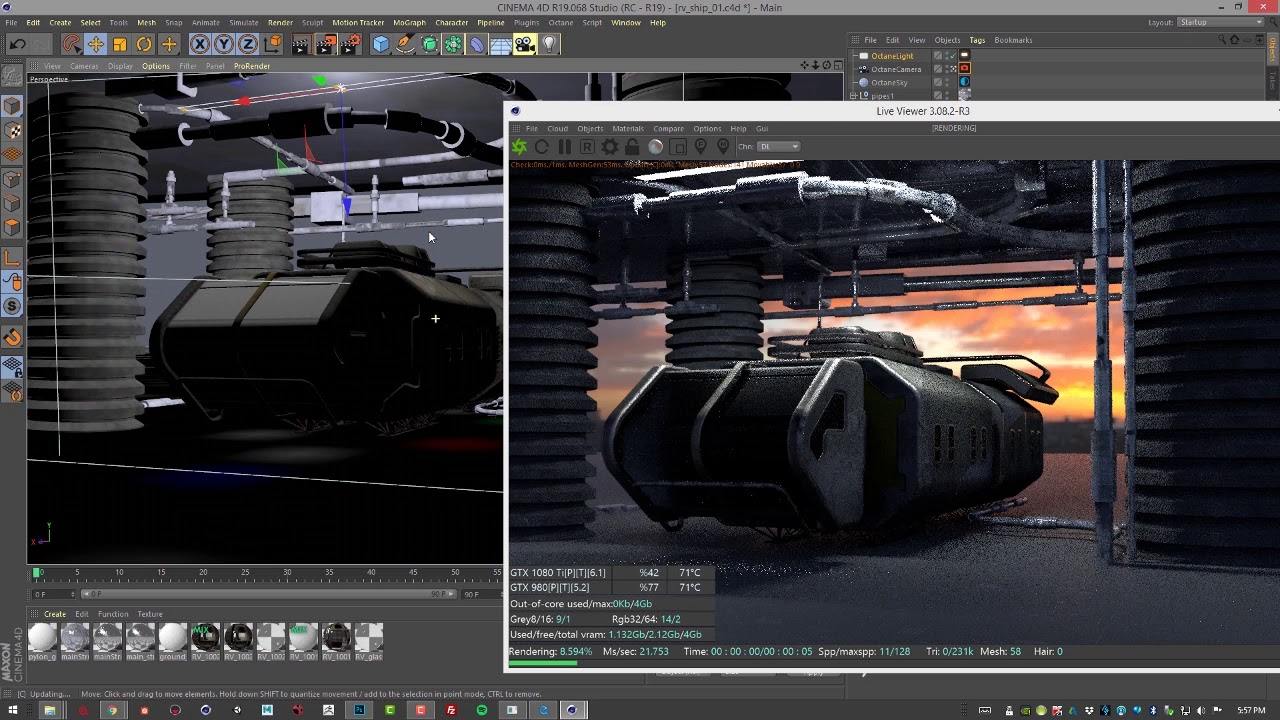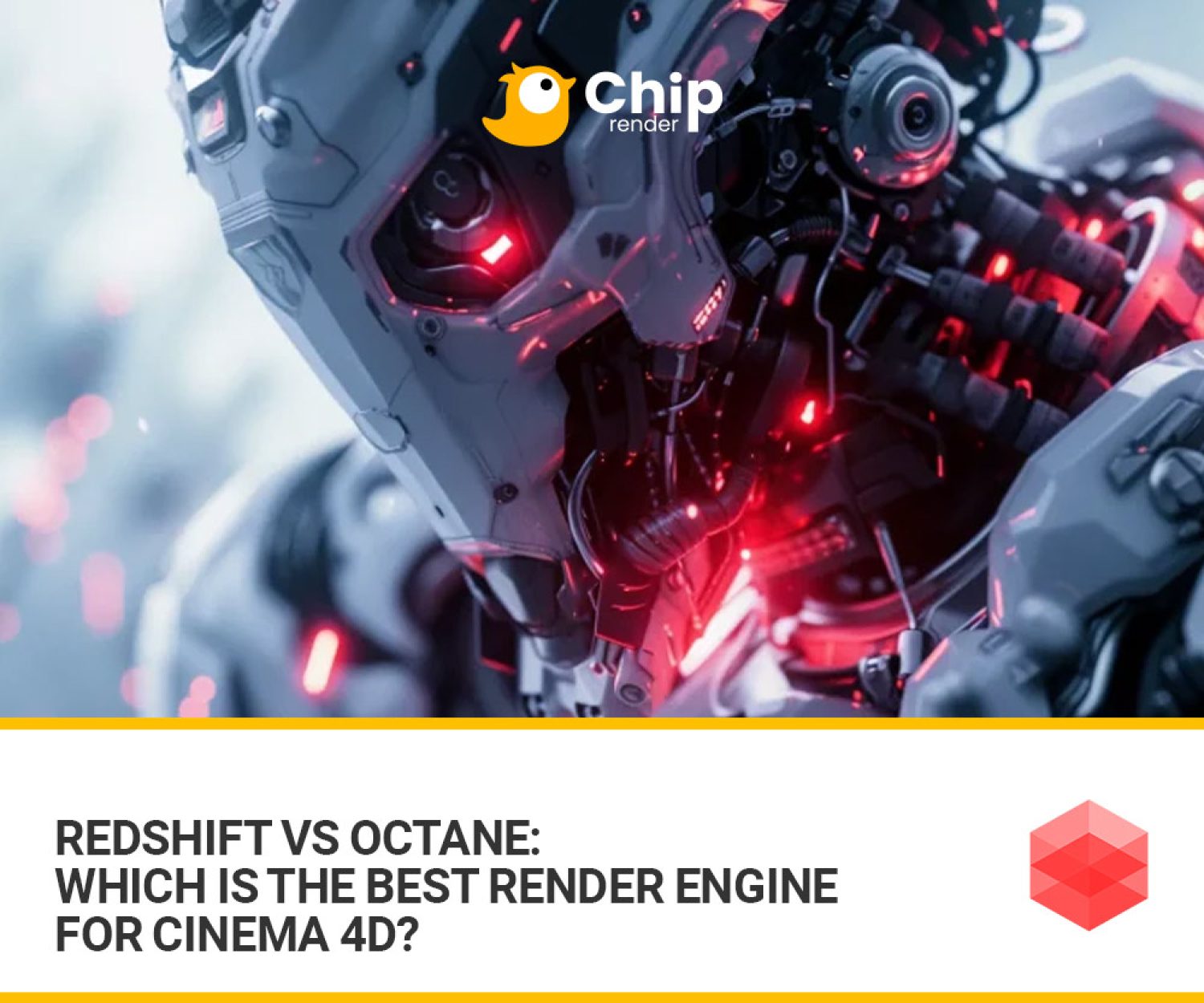Nowadays, GPU-based rendering engines provide effective rendering solutions in terms of speed and quality. Redshift vs Octane are known as two leading competitors. In fact, they deliver high-quality rendering with fast speeds by harnessing GPU power. However, these two rendering engines have different algorithms, Redshift is a biased renderer while Octane is an unbiased render engine.
In this blog, Chip Render will compare Redshift vs Octane in rendering with Cinema 4D. Analysis of rendering quality and speed, features, and price will help you choose the most suitable rendering engine for your project.
Redshift vs Octane: A Brief Introduction
Redshift – The world’s first fully GPU-accelerated, biased render engine
Redshift was launched in 2014 by Redshift Rendering Technologies – a technology company based in California. By April 2019, it was acquired by Maxon (Cinema 4D owner).
This renderer proudly introduces itself as the world’s first fully GPU-powered renderer. Specifically, Redshift provides extensive control capabilities, adjusting refraction in the rendered scene and selecting samples in areas where they are needed. From that, you can have realistic renderings in a short time. This is the right tool for design visualization, advertising, broadcast, and motion graphics which require fast render times.
Main features
| CPU+GPU hybrid rendering | Biased rendering optimization | Physically based shaders |
| Complex materials support | Range of lighting types | Global illumination |
| Motion blur | Adaptive sampling | Deep learning AI denoising |
| Distributed rendering network | Cryptomatte rendering |
Redshift’s biased rendering algorithm avoids wasting samples in less important areas. Thereby, it optimizes rendering much faster than unbiased methods. However, the rendered image may not be physically accurate, but obviously, the balance of speed and quality is important when you’re under a tight deadline, right?
On the other hand, with such in-depth features, users are required to increase their expertise and put in more effort to achieve unique optical effects.

Redshift rendering image via maxon.net
OctaneRender – The fastest unbiased renderer
OctaneRender was launched as the first commercial unbiased rendering engine in 2010 by OTOY. Then, it becomes famous for fast real-time rendering that produces beautiful images. This render engine uses path tracing, along with a new photon tracing kernel that ensures physically accurate lighting, while optimizing render times and image quality.
Main features
| GPU-only rendering | Unbiased path tracing | Spectral rendering pipeline |
| Physically based Uber materials | Metallic/roughness workflows | Volumetric lighting effects |
| Displacement and sub-surface scattering | AI denoising | Interactive viewport preview |
| Scalable across multiple GPUs | Distributed GPU network rendering |
Thanks to being unbiased rendering, Octane delivers rendering with exceptional visual quality. Users can have beautiful scenes with just a little adjustment. In fact, 3D artists agree that Octane is more user-friendly, and even beginners can easily achieve good results.
On the contrary, an unbiased renderer also means longer render times for complex scenes. Splitting performance across GPUs is also less efficient, Octane requires multiple GPU cards to increase rendering speed.

OctaneRender image by Yury Dovganyuk from behance.net
Redshift vs Octane: A Tie Comparison
Integration
Both Redshift vs Octane are rendering engines that are well-compatible with Cinema 4D. However, as mentioned, Redshift and Cinema 4D both belong to Maxon so their compatibility is a bit better. You can access all Redshift features and settings directly from the Cinema 4D interface. In addition, it provides a native rendering environment which makes the rendering process more efficient. Furthermore, Cinema 4D supports APIs to help third-party rendering engines become more powerful.
Render quality
In terms of rendering quality, both Redshift and Octane can produce beautiful, high-quality images.
Octane typically delivers cleaner and sharper results even with materials such as metal, glass, and liquids. Also, this tool handles optics well, with effects like caustics from glass and water appearing extremely realistic. It can be said that Octane provides images as close to reality as possible.
Meanwhile, with Redshift, achieving high fidelity requires users to make many adjustments combined with full sampling. Then users need to be highly expert to handle it well. However, for stylized projects that Octane can’t handle, Redshift gives you extensive control for realistic manipulation.

Redshift for Cinema 4D image via cgrecord.net
Speed
Regarding rendering speed, overall Redshift has a significant advantage thanks to its biased rendering algorithm. In testing, Redshift is 40-50% faster than Octane for the same scenes. Especially with animation and video, Redshift’s rendering speed is even more outstanding, which can save days or even weeks. However, Octane can get a boost with the addition of GPUs. Multiple GPUs allow it to divide the workload, especially rendering complex scenes. Additionally, Octane also allows users to preview adjustments instantly for quick editing if needed.
Features
Both Redshift and Octane have extensive toolsets to handle even the most complex projects.
- Materials and Shaders: Octane stands out with premium materials such as automotive paint, alternative scattering, and volumetric measurement. While Redshift has added similar features including RandomWalk SSS and photon mapping. Both support PBR shaders and utility buttons for adjustments.
- Lighting: Octane’s Caustics are still more realistic, but overall both tools represent environmental lighting well.
- Geometry: The speed factors of movement, division, shaping, or hair and fur are all well supported. In addition, Redshift develops geometry proxies to handle heavy poly meshes.
- World Building: Octane has Sun+Sky rigs while Redshift brings Matte objects. They help integrate light, environment, and atmosphere to create mood and story.
- Rendering: Both use AI denoising to reduce noise while preserving original details.

OctaneRender with Cinema 4D image via Octane Universe YouTube
Price and Licensing
To use Redshift with Cinema 4D, Maxon offers 2 license packages:
- Maxon One: With €170.97 per month, you can access to Cinema 4D, Redshift, and other Maxon applications (Forger, Red Giant, ZBrush, etc.)
- Cinema 4D + Redshift: With €127.92 for a monthly subscription, you can access Cinema 4D and Redshift utilities.
Prices will be cheaper if you subscribe annually. See more about their prices and licenses here.
With Octane, an OctaneRender® Studio+ Subscription gives artists and studios full access to OTOY’s acclaimed OctaneRender VFX software and ecosystem. With just €23.95 per month, you get unlimited network rendering (10+ nodes) and offline rendering support. See detailed prices for the OctaneRender license here.
Render farm support
Redshift is highly compatible and reliable when working with render farms. It is designed to work well with online rendering services using various GPUs. However, Octane is not very friendly with render farms, there are a few render farms that support this tool and Chip Render is one of them.
Being an IaaS model, Chip Render allows users to set up the working environment like their personal computers on our cloud workstations. With multi-GPUs RTX 3090 servers, you will have full control over them to speed up your rendering process.
Sum up
To sum up, Redshift vs Octane are powerful GPU-based rendering engines and well-compatible with Cinema 4D.
- Redshift is a biased rendering engine suitable for projects that require fast rendering speeds such as design visualization, advertising, broadcast, and motion graphics. If you have an in-depth understanding of the tool, then you’ll be able to take advantage of its extensive controls and advanced feature set to achieve the rendering you want. Indeed, with the price and advanced features, it is more reasonable for large studios.
- OctaneRender – an unbiased renderer will help you achieve more realistic rendering thanks to the ability to adjust optics and materials. If you don’t have a tight deadline, then you can be creative. In particular, this renderer is suitable for 3D design, animation, virtual reality, and architectural visualization projects. As a result, with its price and ease of use, it’s easy to access whether you’re a beginner or a small to medium studio.

Chip Render provides your own Cloud Workstation and leverages 1/2/4 x GPU RTX 3090 servers for rendering Redshift or Octane projects. Join us right away to cut your render times with just a small investment from $2.9.




